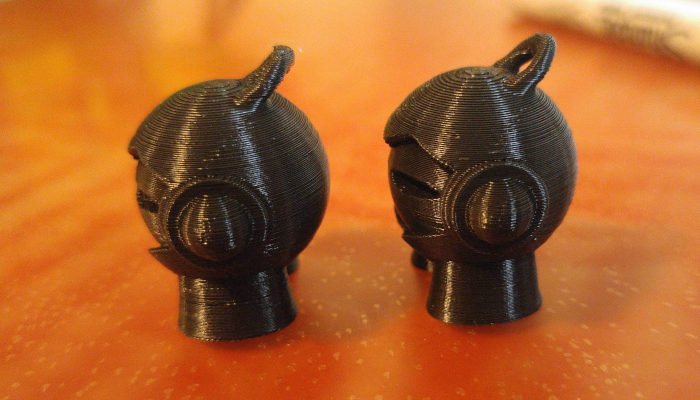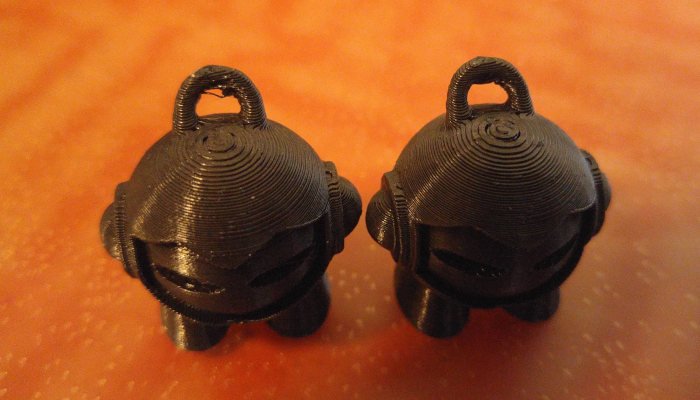Polylactic acid, or PLA, is easily the most popular filament material for 3D printing. But have you heard of its cousin, PLA+?
In the following sections, we’ll explore, in-depth, the differences between PLA and PLA+ filament and which best fits your needs.
What is PLA+
PLA+ is an enhanced version of regular PLA filament, containing special additives that boost the material’s mechanical properties. PLA+ offers much better strength, heat resistance, and layer-to-layer adhesion over conventional PLA, but it will also costs more.
Today, there are many different PLA+ filaments, from brands such as eSun, Sunlu, and Overture. Some brands also call PLA+ other names, like “Pro PLA”, “Tough PLA”, and “PLA Plus”, but it’s the same type of filament.
It’s important to note that different companies each have their own unique PLA+ formula with a distinct set of additives, meaning different PLA+ filaments will perform differently. For example, some PLA+ filaments might contain TPU to make prints more impact-resistant, while others might contain other additives that increase rigidity.
But, generally, PLA+ filaments have better mechanical properties compared to standard PLA.
Overall, PLA+ is a type of PLA marketed to reflect the material’s superior properties, and it’s a great option for printing functional models that require more strength.

PLA vs PLA+: The Differences
Though based on many of the same raw materials, PLA and PLA+ filaments perform very differently.
In the sections below I’ll cover the main differences, including their surface finish, dimensional accuracy, strength, heat resistance, and more.
Surface Finish
You can expect a smoother and more glossy surface finish from PLA+ filament than standard PLA. This stems from PLA+’s higher printing temperatures, which cause the layer lines on prints to more smoothly blend compared to prints made with regular PLA.

But, many other factors, such as build plate texture, bed leveling, and extruder calibration, play into the surface finish of a 3D print, so PLA+ prints might not always be glossier than PLA prints. For example, a simple printing issue like stringing can cause a PLA+ print to come out looking hideous!
Dimensional Accuracy
Dimensional accuracy is very important if you need your 3D prints to be a certain size to fit in, on, or around another part. Typically, the better the tolerance of a filament, the more dimensionally accurate the prints will be.
PLA+ is far better than PLA for dimensional accuracy, with an approximate dimensional accuracy of just 0.03 mm (according to Xometry), which is notably better than the 0.05 mm accuracy of traditional PLA.
This difference in dimensional accuracy stems from the more precise manufacturing process used to make PLA+ filament compared to regular PLA, as well as manufacturers setting a lower tolerance for the filament diameter when producing PLA+. For example, MatterHackers Pro Series PLA has a diameter tolerance of +/- 0.02 mm, while their standard-issue PLA is measured at +/- 0.05 mm.
Because of the better dimensional accuracy, PLA+ filament is a better option when printing functional models or any part that needs to fit somewhere, such as a screw, gear, or snap on panel.
Speed
Generally, traditional PLA can be printed faster than PLA+ filament.
For example, Sunlu recommends printing their regular PLA with a speed of 40-100 mm/s, while capping their speed recommendation for their PLA+ filament at 80 mm/s. While there’s no one answer to this disparity, it’s likely because the higher printing temperature required for PLA+ limits the filament extrusion.
Of course, it’s worth noting that the typical print speed of PLA is 60 mm/s, so you probably won’t get up to 80 or 100 mm/s, but having the ability to do so when time is running out is always nice.
With this in mind, if you’re looking to print parts as fast as possible, go with traditional PLA over PLA+.
Heat Resistance
When it comes to determining a material’s heat resistance, the rule of thumb is to look at the suggested bed temperature, as this is the softening point (AKA glass transition temperature). PLA+ filament tends to offer more heat resistance than standard PLA, typically requiring slightly higher bed temperatures.
Taking a look at MatterHackers’ Build Series (standard) and Pro Series PLA (PLA+), we can see that the PLA+ filament is resistant up to 70°C, while the standard PLA can only withstand 60°C. eSun’s PLA Plus filament is even resistant to deformation up to 80°C.
For more examples of this trend, check out the table below, where I’ve listed the bed temperatures of popular PLA and PLA+ filament:
| PLA Filaments: | Suggested Bed Temperature |
|---|---|
| MatterHackers MH Build Series PLA | 60 °C |
| Sunlu PLA | 65 °C |
| Hatchbox PLA | 60 °C |
| PLA+ Filaments | Suggested Bed Temperature |
| Sunlu PLA Plus | 65 °C |
| MatterHackers Pro Series PLA | 70 °C |
| eSun PLA Plus | 80 °C |
With higher heat resistance, you won’t have to worry about parts melting or deforming under the heat of the sun. So whether you’re 3D printing car dashboard decorations or a part for your outdoor porch, you should always choose PLA+ over standard PLA when the part will face heat.
Ease of Printing
PLA is generally considered the easier material to print with than PLA+, but PLA+ also has some advantages.
First off, the additives used for PLA+ filament make the material’s melting temperature higher, so you’ll have to use a higher nozzle and bed temperature than standard PLA. Because of this, printing issues like under-extrusion, over-extrusion, and stringing tend to be more common with PLA+ filament.
However, PLA+ filament usually yields a better first layer than normal PLA because of the more precise manufacturing techniques used to make this material. Furthermore, according to FilamentPM, PLA+ filament is more consistent, material-wise, than normal PLA filament, so first-layer adhesion issues are much less frequent.
Flexibility
Both PLA and PLA+ are considered rigid filament materials, with nowhere near the level of elasticity as TPU, TPE, or even Nylon filaments. And, though it’s generally accepted that PLA+ offers better impact resistance than a typical PLA filament, the material’s filament tends to be less flexible than traditional PLA.
Drawing from the technical data sheets of MatterHackers’ PLA, we can see that PLA+ has a flexural strength of 83 MPa, a bit lower than the 97 MPa of MatterHackers’ Build Series (standard) PLA filament. As such, PLA tends to be more flexible than PLA+ filament.
But, regardless, I don’t recommend using PLA for any flexible prints, as it is nowhere near as flexible as TPU and Nylon.
Environmental Friendliness
PLA is widely considered the most environmentally friendly 3D printing filament. PLA+ filaments tend to be less biodegradable and environmentally friendly than regular PLA options because of the different additives used to make this material. However, compared to oil-based materials like ABS, PLA+ is still a very environmentally-friendy option.
Sadly, though, neither PLA nor PLA+ are really recyclable as most recycling centers don’t accept this material.
So, if you’re an environmentally-conscious consumer, then you probably will want to use PLA as its lack of additives makes it naturally more biodegradable and environmentally friendly than PLA+.
Toxicity
PLA is known for being a very non-toxic material that’s generally food-safe and produces very little fumes. According to Xometry, PLA+ is also not toxic, but obviously, the additives used in a PLA+ filament vary from manufacturer to manufacturer so this might not always be true.
You should check the manufacturer’s website to see if your PLA+ (and standard PLA) filament is non-toxic, but usually, it will be.
Cost
PLA+ filament is more expensive than standard PLA due to the higher-quality manufacturing process and special additives used for PLA+. Most 1kg spools of PLA+ filament cost between $20 and $26, around 20% more expensive than an average spool of traditional PLA filament ($17-21).
Below, I’ve made a table listing some of the popular PLA and PLA+ filaments with their respective costs:
| PLA Filaments: | Cost per 1kg Spool |
|---|---|
| MatterHackers MH Build Series PLA | $21 |
| Elegoo PLA | $14 |
| Hatchbox PLA | $25 |
| Overture PLA | $21 |
| PLA+ Filaments | Cost per 1kg Spool |
| Polymaker Pro PLA | $25 |
| MatterHackers Pro Series PLA | $52 |
| eSun PLA Plus | $25 |
| Overture PLA+ | $23 |
Uses / Applications
The different mechanical properties of PLA and PLA+ mean each is better suited for very different applications.
Because PLA is easier to print and less expensive, it’s the better option for beginners who want a seamless printing experience at a cheaper price. It’s also ideal if you’re very environmentally conscious.
However, if you’re printing any functional part and still want a very effortless printing experience, PLA+ is for you! This enhanced version of PLA boasts many improved mechanical properties, including higher thermal resistance, tensile strength, impact resistance, and dimensional accuracy. It even yields smoother prints!
So, if you’re printing parts that need to perform under physical stress, such as a gear for a robot, bike attachment, or phone case, PLA+ is the better filament. But, if you’re printing parts that won’t need a lot of strength, such as cosplay pieces or small toys, and you want to print faster or at lower costs, standard PLA filaments will work perfectly!
Storage and Hygroscopy
Storing filament is very important because if the material is more hygroscopic, it will more quickly absorb moisture from the air, degrading the material quality and causing printing issues like stringing or clogging. Luckily, both PLA and PLA+ filaments are not very hygroscopic compared to most printing materials.
Currently, there’s no research into whether PLA or PLA+ is more hygroscopic so there’s no clear winner in this category. However, even if there was an answer, the difference in hygroscopy between these two materials would be very small, so it doesn’t really matter.
You should try to keep your PLA and PLA+ filaments away from humid environments to maximize the quality of your prints. I recommend using a filament dry box to store your filament, but because both of these materials aren’t super hygroscopic, it might not be necessary if your 3D printer is already located in a dry environment.
Post-Processing
Because PLA and PLA+ are sourced from most of the same raw materials, what post-processing techniques you can use are all the same. The only minor difference is that PLA+ prints tend to be smoother from the get-go than PLA parts, so the sanding process might take less time.
But, other than that, the post-processing for these materials is the same, so feel free to sand, layer smooth (with IPA), prime, paint, and polish your PLA or PLA+ prints.
Color Options
With so many filament manufacturers, you can find both PLA and PLA+ filaments in just about every color of the rainbow, from red to violet. However, PLA is more popular than PLA+, so naturally there are more color options for this material. Moreover, while PLA+ still comes in many colors, you can find more exotic color options for normal PLA. Some examples of these special colors that you likely can’t find for PLA+ filament include nebula, amethyst, and Fleck ‘n Forest green.
Alternatives to PLA+
Below, I’ve gone over ABS and PETG, two of my favorite alternatives to PLA+ filament that boast even better strength and durability.
ABS
ABS is one of the most widely-used plastics in the world, and it’s especially popular for 3D printing due to its high durability and heat resistance.
Most 3D printing enthusiasts don’t start out printing ABS because you need an enclosure, a high-temperature heated bed, and a fine-tuned slicer profile to print it well. But, for users that are comfortable dealing with print quality issues and troubleshooting, ABS is a terrific alternative to PLA+.
ABS not only is considered stronger and much less brittle than PLA and PLA+, but it also has more UV and heat resistance, making it the preferred filament material for outdoor and functional prints, like a doorstop or car accessory.
But, if your 3D printer doesn’t have an enclosure, I strongly suggest avoiding ABS as printing in an open-air environment almost always yields low-quality or failed prints.
PETG
PETG is my personal favorite alternative to PLA+, providing more strength while being much easier to print than ABS. Derived from the same material Tupperware containers are made out of, PETG boasts high UV and temperature resistance as well as incredible durability. Because of these properties, PETG is generally a better material option for printing functional and outdoor parts.
But, PETG isn’t all perfect and this filament material is known to cause some printing issues, including over-adhesion to the build plate and stringing. As such, PLA+ is considered easier to work with than PETG, and a better choice for 3D printing novices.
Nonetheless, if you want to print very strong and durable parts and PLA+ just isn’t cutting it for you, definitely consider trying PETG!
FAQs
Will PLA+ Melt In the Sun?
Though PLA+ is more heat and UV resistant than normal PLA, it’s still not advised to use this material for printing outdoor, functional parts. Moreover, PLA+ parts will likely deform or even melt under the sun in a matter of hours. If you’re printing a part that needs to perform under the sun, I suggest using a more weather-proof filament material, such as ABS or PETG.
Can I use PLA+ on an Ender 3?
You can easily print PLA+ filament on a Creality Ender 3 without any additional hardware. Of course, some slicer tuning might be necessary to ensure high-quality prints in PLA+, but the temperature requirements of PLA+ are well within the Ender 3’s capabilities. We recommend checking with the manufacturer of your PLA+ filament to find the best slicer settings (e.g. printing temperature) to use.
How is PLA+ different to ASA?
PLA+ filament is easier to print than ASA but offers slightly worse mechanical properties. It’s recommended to use an enclosure for ASA filament to ensure high-quality prints, but not strictly necessary for PLA+.
ASA has improved mechanical properties, including strength, impact resistance, and heat resistance, for ASA. Because of this, ASA is usually the better option for printing functional parts.
How is PLA+ different to Nylon?
Nylon is a lot more flexible than PLA+ with much better layer adhesion, making it useful for making impact-resistant parts like drone camera mounts.
However, unlike with PLA+ filament, you’ll need a printer with a direct drive extruder and a higher-power nozzle and bed to print Nylon filament. Plus, Nylon is a lot more difficult to work with than PLA+, and most users have to print many test models to achieve high-quality prints in Nylon.
How is PLA+ different to TPU?
PLA+ is a rigid material, while TPU is an extremely flexible material, so the materials are better for different applications. Moreover, PLA+ is the preferred option for printing parts that need to be stiff, such as a phone stand or gear. But TPU, because of its high elasticity, is perfect for making impact-resistant parts that don’t need to hold their own shape, such as a bracelet or shoe sole.





